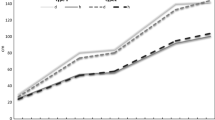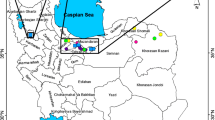Abstract
Rosmarinus officinalis L. (synonym Salvia rosmarinus Schleid) grows in the Mediterranean basin and is known to be a source of natural bioactive compounds and one of the most important aromatic species in terms of the marketing of the essential oil. However, wild collection and the lack of selection lead to the absence of standardized material that ensures the homogeneity and quality of the essential oils over time. In the present work, thirteen wild Spanish populations of rosemary were cultivated in two experimental fields and their essential oil composition monitored during two years. The main compounds present in the essential oils were camphor (21.9%), α-pinene (14.8%), 1,8-cineole (11.6%), β-pinene + myrcene (11.3%) and camphene (8.3%), although their proportions differ greatly among populations. Other terpenes as limonene had a significant presence in some populations, up to 10.2%. The results showed that the variability in the composition of essential oil was mainly controlled by genetics and little affected by soil and climate conditions. Statistical processing allowed to group populations into three different groups based on the geographical origin of the populations. In conclusion, the characterization of essential oils of these populations is a starting point for the development of breeding programmes aimed to commercialize standardized plants (varieties).



Similar content being viewed by others
References
Abdollahi M, Rezaei M, Farzi G (2012) Improvement of active chitosan film properties with rosemary essential oil for food packaging. Int J Food Sci Tech 47:847–853
Abu-Al-Basal MA (2010) Healing potential of Rosmarinus officinalis L. on full-thickness excision cutaneous wounds in alloxan-induced-diabetic BALB/c mice. J Ethnopharmacol 131:443–450
Angioni A, Barra A, Cereti E, Barile D, Coïson JD, Arlorio M, Dessi S, Coroneo V, Cabras P (2004) Chemical composition, plant genetic differences, antimicrobial and antifungal activity investigation of the essential oil of Rosmarinus officinalis L. J Agric Food Chem 52:3530–3535
Bajalan I, Rouzbahani R, Pirbalouti AG, Maggi F (2018) Quali-quantitative variation of essential oil from Iranian rosemary (Rosmarinus officinalis L.) accessions according to environmental factors. J Essent Oil Res 30:16–24
Ben-Jemia M, Tundis R, Pugliese A, Menichini F, Senatore F, Bruno M, Kchouk ME, Loizzo MR (2015) Effect of bioclimatic area on the composition and bioactivity of Tunisian Rosmarinus officinalis essential oils. Nat Prod Res 29:213–222
Bozin B, Mimica-Dukic N, Samojlik I, Jovin E (2007) Antimicrobial and antioxidant properties of rosemary and sage (Rosmarinus officinalis L. and Salvia officinalis L., Lamiaceae) essential oils. J Agric Food Chem 55:7879–7885
Burt S (2004) Essential oils: their antibacterial properties and potential applications in foods—a review. Int J Food Microbiol 94:223–253
Celiktas OY, Hames-Kocabas EE, Bedir E, Vardar-Sukan F, Ozek T, Baser KHC (2007) Antimicrobial activities of methanol extracts and essential oils of Rosmarinus officinalis, depending on location and seasonal variations. Food Chem 100:553–559
Council of Europe (1996) European Pharmacopoeia 3rd. Strasbourg, 1-1799
Drew BT, Guadalupe González-Gallegos J, Xiang C, Kriebel R, Drummond C, Walker J, Sytsma K (2017) Salvia united: the greatest good for the greatest number. Taxon 66(1):133–145
Falconer DS, Mackay TFC (1996) Introduction to quantitative genetics, 4th edn. Addison Wesley Longman, Harlow
Herráiz-Peñalver D, Usano-Alemany J, Cuadrado J, Jordán MJ, Lax V, Sotomayor JA, Palá-Paúl J (2010) Essential oil composition of wild populations of Salvia lavandulifolia Vahl. from Castilla-La Mancha (Spain). Biochem Syst Ecol 38:1224–1230
Isman MB, Wilson JA, Bradbury R (2008) Insecticidal activities of commercial rosemary oils (Rosmarinus officinalis) against larvae of Pseudaletia unipuncta and Trichoplusia ni in relation to their chemical compositions. Pharm Biol 46:82–87
Jiang Y, Wu N, Fu YJ, Wang W, Luo M, Zhao CJ, Zu YG, Liu XL (2011) Chemical composition and antimicrobial activity of the essential oil of rosemary. Environ Toxicol Pharmacol 32:63–68
Jordan MJ, Lax V, Martínez C, Aouissat M, Sotomayor JA (2010) Chemical intraspecific variability and chemotype determination of Rosmarinus officinalis L. in the Region of Murcia. Acta Hortic 625:109–114
Li G, Cervelli C, Ruffoni B, Shachter A, Dudai N (2016) Volatile diversity in wild populations of rosemary (Rosmarinus officinalis L.) from the Tyrrhenian Sea vicinity cultivated under homogeneous environmental conditions. Ind Crop Prod 84:381–390
Lubbe A, Verpoorte R (2011) Cultivation of medicinal and aromatic plants for specialty industrial materials. Ind Crop Prod 34:785–801
Miguel MG (2010) Antioxidant activity of medicinal and aromatic plants. a review. Flavour Frag J 25:291–312
Morales R (2004) Rosmarinus L. In: Castroviejo S, Aedo C, Laínz M, Muñoz-Garmendia F, Nieto-Feliner G, Paiva J, Benedí C (eds) Flora iberica. Real Jardín Botánico, CSIC, Madrid, pp 327–331
Okoh OO, Sadimenko AP, Afolayan AJ (2010) Comparative evaluation of the antibacterial activities of the essential oils of Rosmarinus officinalis L. Obtained by hydrodistillation and solvent free microwave extraction methods. Food Chem 120:308–312
Raskovic A, Milanovic I, Pavlovic N, Cebovic T, Vukmirovik S, Mikov M (2014) Antioxidant activity of rosemary (Rosmarinus officinalis L.) essential oil and its hepatoprotective potential. BMC Complem Altern M 14:225
Salido S, Altarejos J, Nogueras M, Sánchez A, Luque P (2003) Chemical composition and seasonal variations of rosemary oil from Southern Spain. J Essent Oil Res 15:10–14
Santoyo S, Cavero S, Jaime L, Ibáñez E, Senorans FJ, Reglero G (2005) Chemical composition and antimicrobial activity of Rosmarinus officinalis L. essential oil obtained via supercritical fluid extraction. J Food Prot 68:790–795
Satyal P, Jones TH, Lopez EM, McFeeters RL, Ali NAA, Mansi I, Al-kaf AG, Setzer WN (2017) Chemotypic characterization and biological activity of Rosmarinus officinalis. Foods 6:20
Sort J, Calonge J (2011) The actual state of natural Spanish essential oils. IFEAT Conference Proceedings, 3–14
Tak JH, Jovel E, Isman MB (2016) Comparative and synergistic activity of Rosmarinus officinalis L. essential oil constituents against the larvae and an ovarian cell line of the cabbage looper, Trichoplusia ni (Lepidoptera: Noctuidae). Pest Manag Sci 72:474–480
Usano-Alemany J, Palá-Paúl J, Herraiz-Peñalver D (2016) Phenological changes in the biosynthesis and chemical composition of the essential oils. In: Peters M (ed) Essential oils: historical significance, chemical composition and medicinal uses and benefits. Novapublisher, New York, pp 19–50
Varela F, Navarrete P, Cristobal R, Fanlo M, Melero R, Sotomayor JA, Jordán MJ, Cabot P, de Sánchez D, Calvo R, Cases A (2009) Variability in the chemical composition of wild Rosmarinus officinalis L. Acta Hortic 826:167–174
Wang W, Wu N, Zu YG, Fu YJ (2008) Antioxidative activity of Rosmarinus officinalis L. essential oil compared to its main components. Food Chem 108:1019–1022
Wang W, Li N, Luo M, Zu YJ, Efferth T (2012) Antibacterial activity and anticancer activity of Rosmarinus officinalis L. essential oil compared to that of its main components. Molecules 17:2704–2713
Zaouali Y, Boussaid M (2008) Isozyme markers and volatiles in Tunisian Rosmarinus officinalis L. (Lamiaceae): a comparative analysis of population structure. Biochem Syst Ecol 36:11–21
Zaouali Y, Bouzaine T, Boussaid M (2010) Essential oils composition in two Rosmarinus officinalis L. varieties and incidence for antimicrobial and antioxidant activities. Food Chem Toxicol 48:3144–3152
Acknowledgements
This work was supported by the Instituto Nacional de Investigación y Tecnología Agraria y Alimentaria (INIA, Spain, grant RTA2012-00057). We thank to the European Social Fund (ESF) and the Operational Program for Youth Employment 2014/2020 of Castile-La Mancha (JCCM; Spain) for additional financing. We also thank our workmates of CIAF-IRIAF and INIA for providing technical assistance.
Author information
Authors and Affiliations
Corresponding author
Ethics declarations
Conflict of interest
The authors have no conflicts of interest to declare that are relevant to the content of this article.
Additional information
Publisher’s note
Springer Nature remains neutral with regard to jurisdictional claims in published maps and institutional affiliations.
Rights and permissions
About this article
Cite this article
Melero-Bravo, E., Ortiz de Elguea-Culebras, G., Sánchez-Vioque, R. et al. Variability of essential oil in cultivated populations of Rosmarinus officinalis L. in Spain. Euphytica 218, 65 (2022). https://doi.org/10.1007/s10681-022-03020-0
Received:
Accepted:
Published:
DOI: https://doi.org/10.1007/s10681-022-03020-0




